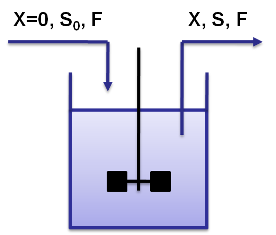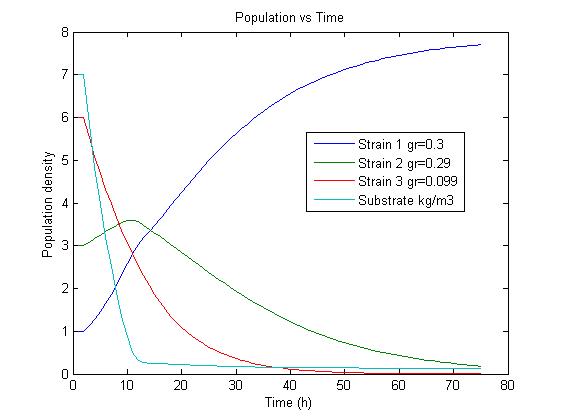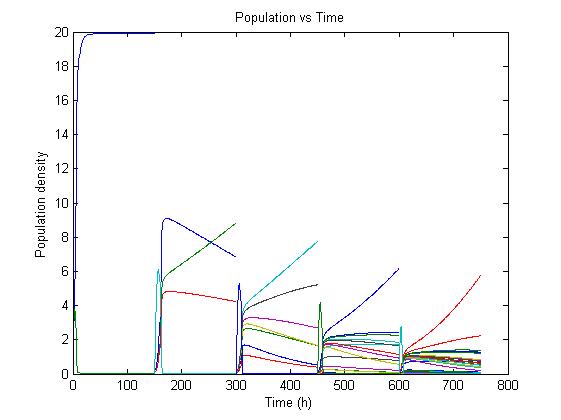Team:ETH Zurich/Modeling/Chemostat Selection
From 2008.igem.org
(→Chemostat Selection) |
m |
||
| Line 4: | Line 4: | ||
</center> | </center> | ||
</html> | </html> | ||
| - | |||
| - | |||
| - | |||
{|style="background:#C6E2FF ; border:3.5px solid #60AFFE; padding: 1em; margin: auto ; width:98.5% " | {|style="background:#C6E2FF ; border:3.5px solid #60AFFE; padding: 1em; margin: auto ; width:98.5% " | ||
|- | |- | ||
Revision as of 19:53, 27 October 2008
Chemostat SelectionAs mentioned in the Project Overview page, one of the main concepts in our project is the possibility to select for organisms with reduced genome size. To achieve this we have thought of letting our system develop in a continuous environment with nucleotide limitation and base the selection method on the difference in growthrate. The aim of this model is to show the applicability of this concept and to determine the parameters for the operation of the chemostat in the lab. The questions we are trying to adress with this model are:
We obtain the results for the calculated growth rates from the flux balance analysis performed in section Genome-Scale Model for the random deletions. These simulations performed on the different strains in our chemostat are used to simulate the development of the population concentrations in continuous culture. The goal is to build a model in which we can vary parameters like substrate feed concentration and dilution rate to optimize the operation of the continuous culture in the lab as described in Chemostat Selection.
Cemostat basicsA chemostat allows for continuous fermentation in a constant volume. It consists of a culture vessel with an input aperture for sterile medium and an overflow aperture to mantain the volume constant. This allows to mantain a constant population in the chemostat but still have continuous cell division.
By varying parameters like the dilution rate (D) and the concentration of nutrients in the medium, different steady states can be obtained, thus allowing to fine tune the selection process. In our case, the feed rate can be set externally and cell growth is limited by a selected nutrient (in our case nucleotides). The specific growth rate in the chemostat can be determined by the material mass balances of biomass and substrate. (Rate of accumulation)=(Input rate) - (Output rate) + (Production rate) The equation for biomass is given by: Where X is the biomass in kg/m3, D the dilution rate in 1/h given by the Monod equation, mu is the growth rate in 1/h, Sf is the feed concentration, S is the substrate concentration and rs substrate rate. Competition in the chemostatWe have extended the basic chemostat model to allow for selection of strains with reduced genome sizes by including mass balances for the biomass of more than one strain. We couple the differential equations in order to let the strains compete for the available limiting substrate. By changing parameters like the different growth rates of the different populations or the dilution rate we can variate the parameters and optimize the selection mechanism. We are interested in the effects of differences in growth rate and dilution rates on the sensitivity of our method to validate our assumptions.
The simulation results confirm our assumtions that a selection for strains showing different growthrates is possible under adequate conditions. The simulation files can be found here. PulseThe next step in our model is to simulate the effect of pulsing the expression of restriction enzyme in our populations. We start the culture with a wildtype strain and let it grow to steady state. By applying a pulse as desribed in the Genome Reduction section we generate mutants. For this model we have assumed, that the expression of restriction enzimes will be very agressive, killing allmost everything in the culture vessel and generating a small amount of mutants with reduced genomes (this assumption can be easily changed in our model). As this step is used to estimate the sensitivity of the selection mechanism, we have varied the growth rate of the mutants by a random change in growthrate of 0.03. This allows to estimate the settings for dilution rate and substrate feed concentration as the diference in growthrate, as this difference in growth rate corresponds with the sensitivity described in the literature [1]. In the next section we will present the results with data obtained from the Genome-Scale Model. The preceding figure shows the possibility to select for strains after a variable number of reduction rounds. We observe, that with increasing number of deletion rounds the sensitivity of the selection method is the limiting factor. Small differences in growth lead to an increase in necessary time to separate the different strains. In this first estimate, the model shows that the strategy to be followed is an increase of selection time between pulses. This is accounted for in the framework where we include the computed growth rates for the reduced mutants. The simulation files can be found here. ResultsTo be completed
We have further estimated a first feasable range for the principal parameters, including dilution rate and feed concentration. In our case and for a difference in growth rate of 0.03 we find values of D= and Sf= We further have a first estimation of the regeneration time between pulses. Here we have also a first set of parameters for the time between pulses of 150 hours, with regeneration times twice as high every 5 to 8 pulses. References(1) "Selection in chemostats." ,D E Dykhuizen and D L Hartl, Journal of Bacteriology, Microbiol Rev. 1983 June; 47(2): 150–168.
|
 "
"





